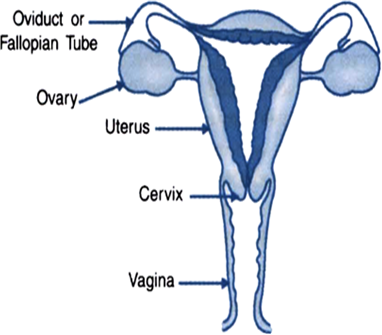With the help of labelled diagram describe the reproductive part of human female.
The female reproductive organs consists of the following:
(1) A pair of ovaries, (2) Fallopian tubes, (3) Uterus, (4) Vagina, (5) Vulva.
(a) Ovaries: The paired ovaries lie on either side of the uterus or lower part of the abdominal cavity. The functions of the ovary are to produce eggs (ova) and hormones notably Estrogens and Progesterone.
(b) Fallopian tubes (Oviducts): These are the two tubes attached to the uterus one on either side. Each tube is about 10-12 cm in length. The fallopian tube-provides for the eggs (ova) to pass into the uterus by ciliary action. It is the site fertilization.
(c) Uterus (Womb): It is a pear shaped hollow muscular organ situated between the urinary bladder and the rectum. It receives the fallopian tubes on either side of uterus and is capable of undergoing great enlargement. Uterus contains developing young and expels it by muscular contraction at birth. It is the site of development of young one.
(d) Vagina: It is a short, wide collapsible muscular tube that connects cervical canal at the upper end with the external genitalia at the lower end. Vagina internally lined by a much folded epithelial layer. The functions of vagina are to receive penis and its ejaculated semen; to act as lower part of birth canal and to act as duct for menstrual flow.
(e) Vulva (External Genitalis): Vulva or the female external genitalis consist of pubis (monsveneris), labia majora, labia minora clitoris, urinary meatus, vaginal orifice and Bartholin’s glands. 
Human female reproductive system



